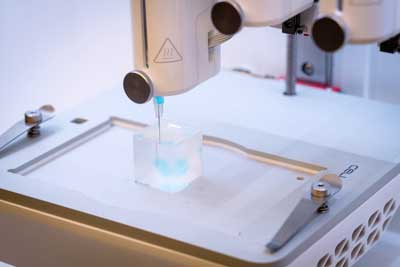| Jul 13, 2020 |
New bioink for cell bioprinting in 3D
|
|
(Nanowerk News) A research group led by Daniel Aili, associate professor at Linköping University, has developed a bioink to print tissue-mimicking material in 3D printers. The scientists have developed a method and a material that allow cells to survive and thrive.
|
|
“Bioprinting is a new and exciting technology to manufacture three-dimensional tissue-mimicking cell cultures. It has been a major problem to develop the bioink required, i.e. a material that can encapsulate the cells and be used in printers. Our bioink has several exciting properties that open new opportunities to approach our vision – creating tissue and organs in the laboratory”, says Daniel Aili, associate professor in the Division of Biophysics and Bioengineering at Linköping University.
|
 |
| Bioprinting. (Image: Magnus Johansson)
|
|
The properties of the ink can be modified as required and they have achieved excellent results in tests when using the material with different cell types: liver cells, heart cells, nerve cells and fibroblasts (a type of cell found in connective tissue). The research group has also solved one of the major challenges when attempting to print organic material: they have found a method that allows the cells to survive and thrive, despite the harsh treatment they receive.
|
|
The results have just been published in the journal Biofabrication ("Dynamic peptide-folding mediated biofunctionalization and modulation of hydrogels for 4D bioprinting").
|
|
The ink the group has developed contains hyaluronan and synthetic molecules similar to proteins, known as peptides. These are bound together in a water-rich network, a hydrogel, that functions as a scaffolding for the cells.
|
|
“We can use some advanced chemical techniques to control how rapidly the hydrogel forms, in other words the transition from liquid to a gel that gently encapsulates the cells”, says Daniel Aili.
|
|
The scientists have developed a modular system, like Lego bricks, in which different components can be combined to create different types of hydrogel. The hydrogels provide mechanical support to the cells and encapsulate them without damaging them. They can also control cell growth and behaviour.
|
|
A system of various peptides makes it possible to modify the properties to control the cells and incorporate various functionalities. One example from the wide array possible is to attach an enzyme that stimulates the growth of bone.
|
|
“We are one of the first research groups that can change the material properties both before and after it is printed. We can, for example, increase the degree of cross-linking during the process to provide more stability to the material, and we can change the biochemical properties. We can also adapt the material to different types of cells. This is a further step on the way to mimicking the support structures that surrounds most human cells, the extracellular matrix”, says Daniel Aili.
|
|
Since the material is dynamic and can be given tailored properties when used as bioink in 3D printing, the result of the research is referred to as a 4D printed biomaterial – yet another step closer to mimicking the body’s own functions.
|
|
“Our work is quite basic research, but we are aware that there is a huge medical need for tissue, and for better and biologically relevant models for drug development, not least as a replacement for animal experiments. Progress is rapid in this field at the moment”, Daniel Aili concludes.
|

